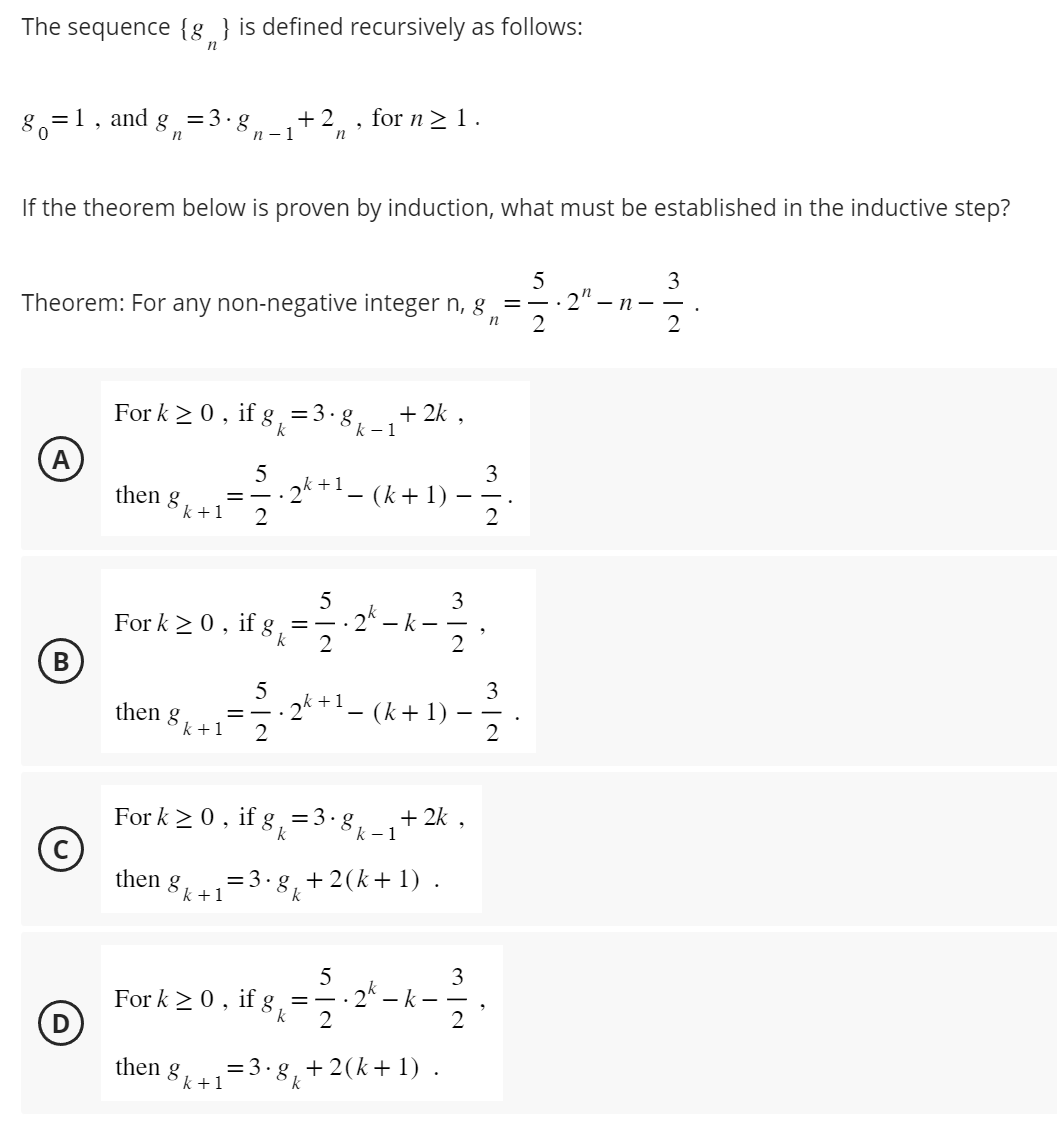The sequence {g} is defined recursively as follows: n 80=1 and ad 8 n = 3.8₁ If the theorem below is proven by induction, what must be established in the inductive step? (A) 5 Theorem: For any non-negative integer n, g = 2" - n- . n 2 B Ⓒ (D) then g For k ≥ 0, if g = 3·8 k-1 +2k, 5 3 = — . 2k +¹ − (k + 1) - 2/2 2 k+1 n-1 then g +2₁, for n ≥ 1. n 5 For k ≥ 0, if g, 20-2¹4- k k+1 then g k+1 -k- For k ≥ 0, if g = 3 ⋅8k_₁+2k, k k-1 5 3 k+1 = -√2₁ 2² + 1 - (K + 1) - 12/2 = 3.g₁ +2(k+1). k 5 For k ≥ 0, if għ = 2 3 2 2k - k- then 8 = 3. 3.8 +2(k+1). k+1 3 2 3 2 .
The sequence {g} is defined recursively as follows: n 80=1 and ad 8 n = 3.8₁ If the theorem below is proven by induction, what must be established in the inductive step? (A) 5 Theorem: For any non-negative integer n, g = 2" - n- . n 2 B Ⓒ (D) then g For k ≥ 0, if g = 3·8 k-1 +2k, 5 3 = — . 2k +¹ − (k + 1) - 2/2 2 k+1 n-1 then g +2₁, for n ≥ 1. n 5 For k ≥ 0, if g, 20-2¹4- k k+1 then g k+1 -k- For k ≥ 0, if g = 3 ⋅8k_₁+2k, k k-1 5 3 k+1 = -√2₁ 2² + 1 - (K + 1) - 12/2 = 3.g₁ +2(k+1). k 5 For k ≥ 0, if għ = 2 3 2 2k - k- then 8 = 3. 3.8 +2(k+1). k+1 3 2 3 2 .
Algebra and Trigonometry (MindTap Course List)
4th Edition
ISBN:9781305071742
Author:James Stewart, Lothar Redlin, Saleem Watson
Publisher:James Stewart, Lothar Redlin, Saleem Watson
Chapter13: Sequences And Series
Section13.CT: Chapter Test
Problem 2CT
Related questions
Question
The sequence { g subscript n } is defined recursively as follows: g subscript 0 = 1, and g subscript n = 3 * g subscript n - 1 end subscript + 2 subscript n, for n greater or = than 1 .
If the theorem below is proven by induction, what must be established in the inductive step?
Theorem: For any non-negative integer n, g subscript n equals 5 over 2 times 2 to the power of n minus n minus 3 over 2 .

Transcribed Image Text:The sequence {g} is defined recursively as follows:
n
80=1 and
ad 8 n = 3.8₁
If the theorem below is proven by induction, what must be established in the inductive step?
(A)
5
Theorem: For any non-negative integer n, g = 2" - n-
.
n
2
B
Ⓒ
(D)
then g
For k ≥ 0, if g = 3·8 k-1 +2k,
5
3
= — . 2k +¹ − (k + 1) - 2/2
2
k+1
n-1
then g
+2₁, for n ≥ 1.
n
5
For k ≥ 0, if g,
20-2¹4-
k
k+1
then g
k+1
-k-
For k ≥ 0, if g = 3 ⋅8k_₁+2k,
k
k-1
5
3
k+1
= -√2₁ 2² + 1 - (K + 1) - 12/2
= 3.g₁ +2(k+1).
k
5
For k ≥ 0, if għ =
2
3
2
2k - k-
then 8 = 3.
3.8 +2(k+1).
k+1
3
2
3
2
.
Expert Solution
This question has been solved!
Explore an expertly crafted, step-by-step solution for a thorough understanding of key concepts.
This is a popular solution!
Trending now
This is a popular solution!
Step by step
Solved in 2 steps

Recommended textbooks for you

Algebra and Trigonometry (MindTap Course List)
Algebra
ISBN:
9781305071742
Author:
James Stewart, Lothar Redlin, Saleem Watson
Publisher:
Cengage Learning

Algebra & Trigonometry with Analytic Geometry
Algebra
ISBN:
9781133382119
Author:
Swokowski
Publisher:
Cengage

College Algebra (MindTap Course List)
Algebra
ISBN:
9781305652231
Author:
R. David Gustafson, Jeff Hughes
Publisher:
Cengage Learning

Algebra and Trigonometry (MindTap Course List)
Algebra
ISBN:
9781305071742
Author:
James Stewart, Lothar Redlin, Saleem Watson
Publisher:
Cengage Learning

Algebra & Trigonometry with Analytic Geometry
Algebra
ISBN:
9781133382119
Author:
Swokowski
Publisher:
Cengage

College Algebra (MindTap Course List)
Algebra
ISBN:
9781305652231
Author:
R. David Gustafson, Jeff Hughes
Publisher:
Cengage Learning
